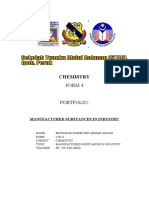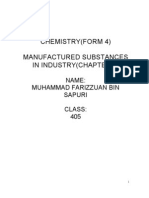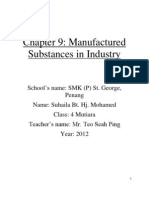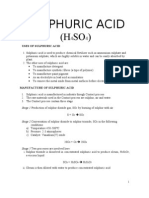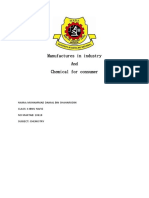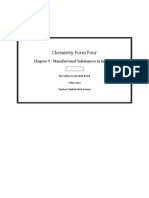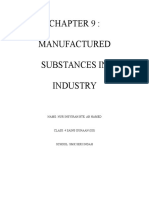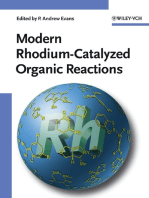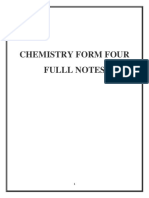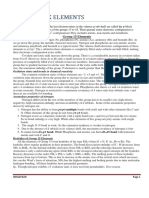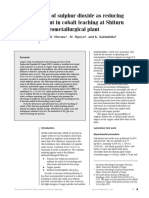9.1: Sulphuric Acid
9.1: Sulphuric Acid
Uploaded by
Syaza JeaCopyright:
Available Formats
9.1: Sulphuric Acid
9.1: Sulphuric Acid
Uploaded by
Syaza JeaOriginal Title
Copyright
Available Formats
Share this document
Did you find this document useful?
Is this content inappropriate?
Copyright:
Available Formats
9.1: Sulphuric Acid
9.1: Sulphuric Acid
Uploaded by
Syaza JeaCopyright:
Available Formats
9.
1 : Sulphuric acid
Properties of sulphuric acid
Sulphuric acid is a powerful protonating agent. It is also a moderately strong oxidizing agent. Sulphuric acid is also a powerful dehydrating agent and is used to remove a molecule of water from many organic compounds. In dilute solution, sulphuric acid is a strong dibasic acid forming two series of salts.
A Dibasic Acid has two acidic hydrogen atoms in its molecules which can be ionised. Sulphuric Acid, H2SO4, is a dibasic acid, because it contains two hydrogens atoms which ionise in aqueous solution to become Hydrogen Ions, H(+). H2SO4 2 H(+) + SO4(2 -)
Sulphuric acid is an important industrial chemical and it has many uses as a strong oxidising agent and a powerful dehydrating agent. Commercially available sulphuric acid is as a 96-98% solution of the acid in water. It is a powerful protonating agent. It is also a powerful dehydrating agent and is used to remove a molecule of Water, HO2, from many organic compounds. The Dehydration Reactions of Alcohols results in their converted into an alkene, and involves the elimination of a molecule of water. Dehydration requires the presence of an acid and the application of heat.
Industrial process in manufacture of sulphuric acid 1. Sulphuric acid, H2SO4 is manufactured in industry through the Contact process. 2. The manufacturing of sulphuric acid, H2SO4 in industry involves three stages. Stage 1 Sulphur dioxide, SO2 gas can be produced by burning sulphur in air. S(s) + O2(g) SO2(g) Aim : to produce sulphur dioxide, SO2 gas Stage 2 The gas mixture of sulphur dioxide, SO2 and oxygen, O2 is passed over vanadium (V) oxide, V2O5 (catalyst) at a temperature of 450-500 oC and under pressure of 1 atmosphere. 2SO2(g) + O2(g) 2SO3(g) Aim : to produce sulphur trioxide, SO3 gas Stage 3 Sulphur trioxide, SO3 gas is dissolved in concentrated sulphuric acid, H2SO4 to form oleum, H2S2O7. SO3(g) + H2SO4(i) H2S2O7(i) Water is then added to the oleum, H2S2O7 to dilute it to produce sulphuric acid, H2SO4. H2S2O7(i) + H2O(i) 2H2SO4(i) Aim : to produce sulphuric acid, H2SO4
Flow chart of the Contact process
Environmental pollution by sulphur dioxide 1. Fossil fuels such as petrol and manufactured products of sulphuric acid, H2SO4 contain sulphur, S. 2. Burning of these products will oxidise sulphur, S to form sulphur dioxide, SO2.
3.
4.
5.
6.
S(s) + O2(g) SO2(g) Sulphur dioxide, SO2 is an acidic gas. When it dissolves in rainwater, it forms sulphurous acid, H2SO3 and causes acid rain. SO2(g) + H2O H2SO3(aq) Sulphur trioxide, SO3 will also form when sulphur dioxide, SO2 reacts with oxygen, O2 in air. 2SO2(g) + O2(g) 2SO3(g) When sulphur trioxide, SO3 dissolves in rainwater, sulphuric acid, H2SO4 is also formed causing acid rain. SO3(g) + H2SO4(i) H2S2O7(i) The effects of acid rain on the environment are as follows : a. Corrodes and destroys property such as bridges, buildings and statues b. Reduces pH of soil and causes it to be unsuitable for plant life c. Reduces pH of water and causes the death of aquatic life d. Destroys the beauty of the environment such as the collapse of limestone caves
9.2 : Ammonium and its salt
Manufacture of ammonia 1. Ammonia, NH3 is manufactured on a large scale in factories through the Haber process. 2. In the Haber process, nitrogen, N2 and hydrogen, H2 gases are mixed in the ratio of 1:3 volumes. N2(g) + 3H2(g) 2NH3(g) 3. The hydrogen, H2 gas is obtained from methane, CH4 , a type of natural gas, while nitrogen, N2 gas is obtained from air by fractional distillation of liquefied air.
4. The gas mixture is passed over iron at a temperature of 450 550 oC and compressed under a pressure of 200 500 atmosphere. 5. The ammonia, NH3 gas is obtained is cooled to become liquid ammonia, NH3(l).
( flow chart of production of ammonia, NH3 through the Haber process )
( synthesis of ammonia, NH3 in industry )
Preparations of ammonium fertilisers in the laboratory 1. Ammonium fertilisers are nitrogenous fertilisers that can provide nitrogen elements to plants. Examples : ammonium nitrate, NH4NO3 , ammonium sulphate, (NH4)2SO4 , and ammonium phosphate, (NH4)3PO4. 2. Ammonia, NH3 dissolves in water to form ammonia solution, NH3(aq). 3. Neutralisation reaction between ammonia solution, NH3(aq) and acid solution produces ammonium, NH4+ salt which is used as fertilisers.
Neutralisation reaction Ammonia solution + phosphoric acid Ammonia solution + nitric acid Ammonia solution + sulphuric acid
Ammonium salt ( fertilisers ) Ammonium phosphate Ammonium nitrate Ammonium sulphate
9.3 Alloys
Arrangement of atoms in pure metal 1. Pure metal is soft and not very strong. 2. Atoms are pure metals have similar size and shape, and are arranged closely but there is still space between atoms. 3. When force is applied to pure metals, the atoms slide along one another easily. 4. This property causes pure metal to be ductile, it can be stretched into a wire. 5. When knocked or hammered, metals atoms slide along one another to fill spaces between the metal atoms. 6. This property causes pure metal to be malleable, it can be knocked or pressed into varioys desired shapes.
Alloys 1. An alloy is a compound formed from a mixture of metal and other elements. 2. An impurity atom may be atoms of other metals or non-metals such as carbon. 3. The process of mixing atoms of impurities with atoms of pure metal by melting is called alloying. 4. The aims of alloying are to: a. Increase the strength and hardness of the metal b. Prevent corrosion of the metal c. Improve the appearance of the metal so that it is more attractive
Arrangement of atoms in alloys 1. Impurity atoms which are mixed may be larger or smaller than atoms of pure metal. 2. Impurity atoms fill the empty spaces between the atoms in pure metal. 3. Impurity atoms can prevent the layers of metal atoms from sliding along one another easily. 4. Due to this, an alloy is harder and stronger than pure metal.
9.4 Synthetic polymers and their uses
1. Polymers are long chains of molecules made from combinations of many small molecules.
2. Small molecules that combine to form polymers are called monomers. 3. Polymerisation is a process of combining monomers to form a long chain of molecules. 4. Polymers can be divided into two types: a. Natural polymer b. Synthetic polymer Natural polymer 1. A natural polymer is a polymer that occurs naturally. 2. Natural polymers are normally made by living organisms. Natural polymer Rubber Cellulose Starch Protein Fat Nucleic acid Monomers Isoprene Glucose Glucose Amino acid Fatty acids and glycerol Nucleotides
( examples of natural polymers and their monomers ) Synthetic polymers 1. Synthetic polymers are man-made polymers that are produced from chemical compounds through polymerisation. 2. Plastic, synthetic fibres and synthetic rubbers are three examples of synthetic polymers. 3. There are two types of polymerisation: a. Addition polymerisation Unsaturated monomers that contain double bonds between two carbon atoms undergo addition polymerisation. Monomers undergo addition polymerisation:
If the structure of a monomer is known, the structural formula of its synthetic polymer can be determined as shown below.
The monomers in a polymer can be determined.
a. Condensation polymerisation Small molecules such as water, H2O and ammonia, NH3 are released in condensation polymerisation. Monomer Adipic acid and hexanediamine 1,4-dicarboxylbenzene and ethane-1,2diol Polymer Nylon Terylene
(example of synthetic polymers [products of condensation polymerisation] and their monomers)
Uses of synthetic polymers 1. Synthetic polymers are used widely in life. Type of polymer Polythene Polyvinyl chloride (PVC) Polypropene Perspex Nylon Polystyrene Terylene Use Make buckets, plastic bags, raincoats, films, bowls and rubbish bin Make water pipes, electric cables, mats, vinyl records and clothes hangers Make ropes, bottles, chairs, drink cans and carpets Make car windscreens, airplane window panes and spectacle lenses Make ropes, curtains, stockings and clothes Make packing boxes, buttons and noticeboards Make textile items such as clothes and cloths
2. Synthetic polymers have been used to replace various natural items.
Natural compounds that have been replaced by synthetic polymers Cotton and silk Paper Timber Metal Glass and ceramics Marble
The advantages of synthetic polymers compared to natural compounds Stronger, more durable, withstands dirt and not wrinkle easily Waterproof, does not wrinkle or tear easily Does not rot easily Lighter, does not corrode easily, more easily forged and coloured Does not break easily Cheaper
Effects of the disposal of items made from synthetic polymers on the environment 1. Synthetic polymers are not biodegradable. 2. The careless disposal of items made from synthetic polymers such as plastic causes environment pollution. 3. The effects of burning and careless disposal of items made from synthetic polymers on the environment are as follows: a. Burning of synthetic polymers Releases pollutants that endanger health such as smoke, gases that are smelly, poisonous and corrosive such as sulphur dioxide, pollutants that cause acid rain and the greenhouse effects. a. Careless disposal of synthetic polymers Spoils the beauty of the environment Causes flash floods during heavy rainfall Endangers marine life like turtles that accidently eat polymers such as plastic as its food 1. The best way to manage used items made from synthetic polymers is to recycle them. 2. Plastics that are biodegradable can be used instead to reduce environmental pollution.
9.5 The uses of glass and ceramics
Types, composition, characteristics and uses of glass 1. The main component of glass is silica or silicon dioxide, SiO2 which is obtained from sand. 2. The main characteristics of glass are: a. Brittle b. Hard c. Chemically inert d. Transparent e. Not permeable to gas and liquid
f. Does not conduct electricity g. Heat insulator 1. The most simple glass is the fused silica glass. This glass mainly contains silica, SiO2. 2. Most of the glasses are produced by mixing molten silica, SiO2 with other compounds. 3. Glass can be recycled. Glass can also be melted and solidified repeatedly. Type of glass Fused silica glass Method of production Silica, SiO2 is heated until melted at 1700 oC and cooled rapidly Composition Silica or silicon dioxide, SiO2 Properties Very high melting point Not easy to change its shape Does not easily expand or shrink with changes of temperature Transparent to ultraviolet ray Transparent Low melting point Easily shaped Easily broken Cannot withstand heat and chemical reactions
Soda-lime glass Molten silica, SiO2 is mixed with sodium carbonate, Na2CO3 and calcium carbonate, CaCO3 at 1500 oC and cooled Molten silica, SiO2 is mixed with boron oxide, B2O3 Sodium silicate, Na2SiO3 and calcium silicate, CaSiO3
Borosilicate glass
Silica, SiO2 and boron oxide, B2O3
Withstand heat and chemical reactions High melting point Transparent to light and infrared ray but not to ultraviolet ray Expands and shrinks very little and only when temperature changes Very transparent Shiny High refractive index
Lead crystal glass
Molten silica, SiO2 is mixed with lead (ll) oxide, PbO and sodium oxide,
Silica, SiO2 , lead (ll) oxide, PbO and sodium oxide,
Na2O
Na2O
High deensity
1. Different types of glass have different uses. Types of glass Fused silica glass Soda-lime glass Borosilicate glass Uses Lenses, spectacles, laboratory glassware, ultraviolet column Bottles, glass containers, mirrors, electrical bulbs, glass windows Bowls, plates, saucers, pots, cookware, automobile headlights and laboratory glassware such as test tubes, beakers and flasks Lenses, prisms, glasses and ornamental items (crystals)
Lead crystal glass
Composition, properties and uses of ceramics 1. Ceramics are made from clay that has been heated at a very high temperature. 2. The main component of ceramics is silicate. 3. Most ceramics contain silicon, Si , oxygen, O , and aluminium Al. 4. Unlike glass, ceramics cannot be recycled. Ceramics that have been solidified cannot be melted again as they are extremely heat resistant. 5. Common properties of ceramics are: a. Brittle b. Extremely hard c. High melting point d. Withstand compression e. Cracks when temperature changes drastically f. Inert to chemicals (withstand corrosion) g. Good insulators of heat and electricity 1. Several uses of ceramics are as follows: a. Manufacture of computers microchips b. Make dentures c. Make porcelain, vase and ornamental items d. Make plates, bowls and pots e. Used in the manufacturing of car engines, spacecraft, superconductors and nuclear reactors f. Make construction materials such as bricks, cement, tiles, underground piping or roof tiles
9.6 The uses of composite materials
Composite materials 1. Composite materials are produced from the combination of two or more different compounds such as alloys, metals, glass, polymers and ceramics. 2. The characteristics of the produced material are much more superior than those original components. 3. Several uses of composite materials are: a. Reinforced concrete Made from a mixture of cement, gravel, sand, water, iron or steel to produce nets, rods or bars Strong, high tensile strength and cheap Construction materials for buildings, bridges, highways and dams a. Superconductor Made from various components such as the mixture of niobium and germanium Compound that has no electrical resistance Can function only under extremely low temperatures Used in the transportation, telecommunications and astronomy industries and in the medical field a. Fibre glass Made from silica, SiO2 , sodium carbonate, Na2CO33 , and calcium carbonate, CaCO3 Good insulator of heat and electricity Used to make protective apparel for astronauts and firefighters a. Fibre optics Made from glass, copper and aluminium Enables information to be transmitted in light form at high speeds Used in the field of communications to make electrical cables and in the field of medicine to observe internal organs without performing surgery a. Photochromic glass Produced from molten silica that is mixed with a little silver chloride, AgCl Dark in colour when exposed to bright light and bright when in dark
Used to make optical lenses and glass windows of certain vehicles a. Ceramic glass Produced by exposing glass that contains certain amount of metals to ultraviolet rays and heating it at high temperature Used to make cooking materials and rocket heads a. Plastic strengthened with glass fibres Made of plastic and glass fibres Composite plastics that are very strong, light, easily formed and can withstand corrosion Used to make helmets, the body of cars and aeroplanes, rods and other parts of aeroplanes
You might also like
- N5 Chemistry PPQs StrontiumDocument271 pagesN5 Chemistry PPQs Strontiummilneda31No ratings yet
- Esm 311Document71 pagesEsm 311Akinfolarin AdewaleNo ratings yet
- Folio Chemistry F4 (Manufactured Substances in Industry)Document31 pagesFolio Chemistry F4 (Manufactured Substances in Industry)JackOss93No ratings yet
- Chemistry Form 4 (Manufactured Substances in Industries)Document24 pagesChemistry Form 4 (Manufactured Substances in Industries)Fariezuan HamidNo ratings yet
- Chemistry Chapter-05 Questions and AnswerDocument68 pagesChemistry Chapter-05 Questions and Answerrnp2007123No ratings yet
- Chapter 9: Manufactured Substances in Industry: Stage 1Document12 pagesChapter 9: Manufactured Substances in Industry: Stage 1malcovishesNo ratings yet
- Objective: Concept MapDocument17 pagesObjective: Concept MapNenek Tak Guna100% (1)
- Chemistry Folio Form 4 2013Document17 pagesChemistry Folio Form 4 2013Megat AshmannNo ratings yet
- Folio Chemistry Chapter 9Document21 pagesFolio Chemistry Chapter 9Fatin Nadzirah YusofNo ratings yet
- Chemistry Folio Manufacture Substance in IndustryDocument23 pagesChemistry Folio Manufacture Substance in Industryseela gunalanNo ratings yet
- Chemistry (Form 4) Manufactured Substances in Industry (Chapter 9)Document43 pagesChemistry (Form 4) Manufactured Substances in Industry (Chapter 9)Zafirah IdrisNo ratings yet
- Chemistry Folio Chapter 9 Form 4Document27 pagesChemistry Folio Chapter 9 Form 4Suhaila MohamedNo ratings yet
- Chemistry Form 4: Manufactured Substances in IndustryDocument12 pagesChemistry Form 4: Manufactured Substances in IndustryQisthina Azmina AbdullahNo ratings yet
- Manufacture D Substances in IndustryDocument53 pagesManufacture D Substances in IndustrySuriana ShamsuddinNo ratings yet
- Chemistry: Manufactured Subtances in IndustryDocument29 pagesChemistry: Manufactured Subtances in IndustrySaber DateNo ratings yet
- ChemDocument32 pagesChemSurinjeet KaurNo ratings yet
- Manufactured Substances in Industry2Document20 pagesManufactured Substances in Industry2Sam ZeeNo ratings yet
- Sekolah Menengah Sains Seri Puteri Kuala Lumpur: Manufactured Substances in IndustryDocument21 pagesSekolah Menengah Sains Seri Puteri Kuala Lumpur: Manufactured Substances in IndustryNur Wani Amat SujangiNo ratings yet
- Chemistr Y: Manufactured Substances in IndustryDocument26 pagesChemistr Y: Manufactured Substances in IndustryMuhd AmirudDinNo ratings yet
- Chemistry Form 4 Solihin Full 1Document24 pagesChemistry Form 4 Solihin Full 1Aiman ShuhaimiNo ratings yet
- Folio ChemistryDocument16 pagesFolio Chemistryamirah_dayanaNo ratings yet
- Mind MapDocument16 pagesMind MapJr SparkNo ratings yet
- FolioDocument24 pagesFolioHeng CzNo ratings yet
- ChemistryDocument6 pagesChemistryshaz_suryaNo ratings yet
- Uses of Sulphuric AcidDocument18 pagesUses of Sulphuric AcidJian Jet LeeNo ratings yet
- Folio Chemis AyiepDocument15 pagesFolio Chemis AyiepAniece AmirahNo ratings yet
- Folio Kimia Bab 9 Tingkatan 4Document27 pagesFolio Kimia Bab 9 Tingkatan 4Muhammad Ikhlas100% (8)
- Kimia Chapter 9Document35 pagesKimia Chapter 9Mohammad AmirNo ratings yet
- Chemistry F4 AssignmentDocument18 pagesChemistry F4 AssignmentFazrul AminNo ratings yet
- ConclusionDocument2 pagesConclusionnurulsyamim0% (1)
- Form 4 ChemistryDocument15 pagesForm 4 ChemistryKia LisaNo ratings yet
- Chemistry Holidays Assignment: Form 4Document39 pagesChemistry Holidays Assignment: Form 4Hafiz HakimiNo ratings yet
- Folio KimiaDocument12 pagesFolio KimiaAishiteru RamenNo ratings yet
- Manufactured Subtances IN IndustryDocument49 pagesManufactured Subtances IN IndustryAhmad AzriNo ratings yet
- NON-METALS (Trple) (2) 4Document14 pagesNON-METALS (Trple) (2) 4candy lebotseNo ratings yet
- Flashcards - Topic 11 Air and Water - CAIE Chemistry IGCSEDocument77 pagesFlashcards - Topic 11 Air and Water - CAIE Chemistry IGCSEKendrickNo ratings yet
- KkimiaDocument27 pagesKkimiaNoralyz LyzcatNo ratings yet
- Uses of H SODocument12 pagesUses of H SOFaakir GhazaliNo ratings yet
- Name: Amierul Bin Anuar Form: 4 Inovatif Subject Teacher: en NorazwanDocument7 pagesName: Amierul Bin Anuar Form: 4 Inovatif Subject Teacher: en NorazwanAmierul AnuarNo ratings yet
- Sulphuric Acid, H SODocument9 pagesSulphuric Acid, H SOcommen100% (3)
- Manufactures in Industry and Chemical For ConsumerDocument22 pagesManufactures in Industry and Chemical For ConsumerMuhammad DanishNo ratings yet
- Non-Metals ProjectDocument14 pagesNon-Metals ProjectArunNo ratings yet
- Nitrgen Fertlisers-1Document8 pagesNitrgen Fertlisers-1Imen KsibiNo ratings yet
- PiniSulphuric AcidDocument15 pagesPiniSulphuric AcidAsiah AsNo ratings yet
- Chapter 9: Manufactured Substances in Industry: UsesDocument9 pagesChapter 9: Manufactured Substances in Industry: Useseyeda2000No ratings yet
- Chemistry of The EnvironmentDocument36 pagesChemistry of The Environmentmohamed amirNo ratings yet
- Chapter 9 Folio: Manufactured Substances in Industry.: ChemistryDocument15 pagesChapter 9 Folio: Manufactured Substances in Industry.: ChemistryFaizul IzhamNo ratings yet
- Acids Bases and SaltsDocument4 pagesAcids Bases and Salts01.akki.1999No ratings yet
- Chemistry Form 4 Chapter 9aDocument26 pagesChemistry Form 4 Chapter 9aEric MokNo ratings yet
- ChemistryDocument24 pagesChemistryBushra Amir X-G-ANo ratings yet
- Chemistry Form 4 Auto SavedDocument21 pagesChemistry Form 4 Auto SavedTharshini ArivananthanNo ratings yet
- Sulphuric Acid and AmmoniaDocument9 pagesSulphuric Acid and Ammoniaash ashNo ratings yet
- Chemistry Form Four: Chapter 9: Manufactured Substances in IndustryDocument16 pagesChemistry Form Four: Chapter 9: Manufactured Substances in IndustrySafina IzwaniNo ratings yet
- Manufactured Substances in IndustryDocument4 pagesManufactured Substances in Industrylurvechocolate94No ratings yet
- Chemistry Form 4 Chapter 9Document24 pagesChemistry Form 4 Chapter 9Raatheys RaoNo ratings yet
- Chemistry Form Four: Chapter 9: Manufactured Substances in IndustryDocument18 pagesChemistry Form Four: Chapter 9: Manufactured Substances in IndustrySafina IzwaniNo ratings yet
- Modern Rhodium-Catalyzed Organic ReactionsFrom EverandModern Rhodium-Catalyzed Organic ReactionsP. Andrew EvansNo ratings yet
- Ion Exchange Resins and Adsorbents in Chemical Processing: Second EditionFrom EverandIon Exchange Resins and Adsorbents in Chemical Processing: Second EditionRating: 5 out of 5 stars5/5 (1)
- Explanatory Notes On Clean Air RegulationDocument34 pagesExplanatory Notes On Clean Air RegulationLean Seey TanNo ratings yet
- The Elements of GROUP 4A-5A-6ADocument41 pagesThe Elements of GROUP 4A-5A-6AgodraaNo ratings yet
- TES-AMM Analysis Pyrometallurgy Vs Hydrometallurgy April 2008Document6 pagesTES-AMM Analysis Pyrometallurgy Vs Hydrometallurgy April 2008papiloma753100% (1)
- Sterlite Industries Vs Chairman TNPCBDocument145 pagesSterlite Industries Vs Chairman TNPCBVaishnavi JayakumarNo ratings yet
- SAPDocument16 pagesSAPsourav84No ratings yet
- Material Balance Problems Involving Multiple UnitsDocument11 pagesMaterial Balance Problems Involving Multiple UnitsMay Reis BalagNo ratings yet
- Chemistry Form Four PDFDocument215 pagesChemistry Form Four PDFshimba jilalaNo ratings yet
- AMETEK 900 Air Demand Analyzer10Document2 pagesAMETEK 900 Air Demand Analyzer10Lakshman TangellaNo ratings yet
- Judgement On TTZDocument48 pagesJudgement On TTZGopal SharmaNo ratings yet
- The P - Block Elements 2Document16 pagesThe P - Block Elements 2prateekNo ratings yet
- Environmental Engineering Questions IndiabixDocument22 pagesEnvironmental Engineering Questions IndiabixPavan Kalyan100% (1)
- Chapter 16 Environmental Chemistry (Ib Option E) Summary: Air PollutionDocument7 pagesChapter 16 Environmental Chemistry (Ib Option E) Summary: Air Pollutionalstjq1003No ratings yet
- MCQ On Sulfuric Acid PreparationDocument6 pagesMCQ On Sulfuric Acid PreparationShanku Pratim BorahNo ratings yet
- Sources of Air PollutionDocument17 pagesSources of Air PollutionJaypee EvangelistaNo ratings yet
- Chemistry Revision GuideDocument273 pagesChemistry Revision GuideDockins MairuraNo ratings yet
- Makalah B.inggrisDocument9 pagesMakalah B.inggrisclaudia debby junera dickyNo ratings yet
- Analysis of Limestone For Flue Gas Desulfurization in A Power PlantDocument2 pagesAnalysis of Limestone For Flue Gas Desulfurization in A Power PlantSudheer NairNo ratings yet
- Use of SO2 As Reducing Agent in Cobalt Leaching PDFDocument4 pagesUse of SO2 As Reducing Agent in Cobalt Leaching PDFBen KalNo ratings yet
- Balancing EquationsDocument4 pagesBalancing EquationsErwin Cabangal100% (1)
- Sulphuric Acid Production-Installation 3-5Document8 pagesSulphuric Acid Production-Installation 3-5samehmo.abdoNo ratings yet
- Expt 1 SO2 EnglishDocument7 pagesExpt 1 SO2 EnglishGuillermo Iglesias GarcíaNo ratings yet
- ChECal SolutionsDocument39 pagesChECal SolutionsMARGARET FLORESNo ratings yet
- Sulfuric Acid Production Sulfuric Acid: By: Carl Cesar H. BibatDocument7 pagesSulfuric Acid Production Sulfuric Acid: By: Carl Cesar H. BibatSam Denielle TugaoenNo ratings yet
- VINIFICATIONDocument26 pagesVINIFICATIONaboutkimonNo ratings yet
- Mole Concept J PDFDocument15 pagesMole Concept J PDFSamyak JhaNo ratings yet
- THESIS - FINAL With Chapter IV and VDocument28 pagesTHESIS - FINAL With Chapter IV and VConrad EsquejoNo ratings yet
- Sulphur: Heat Recovery in Acid PlantsDocument8 pagesSulphur: Heat Recovery in Acid PlantsGajendra MehtaNo ratings yet



